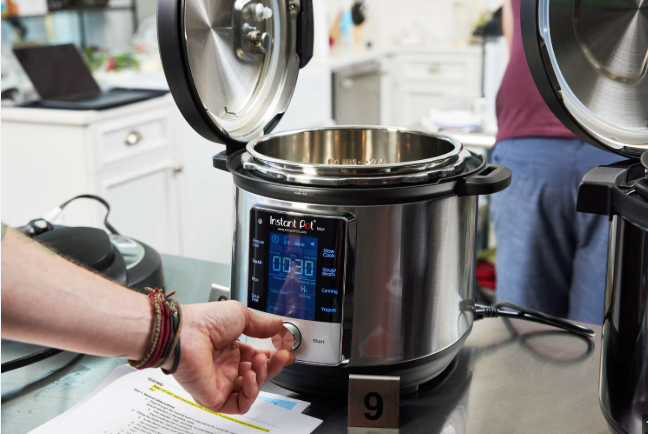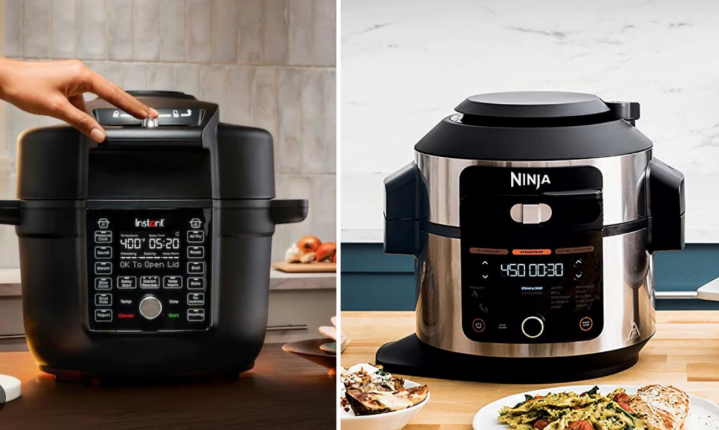In the battle of Instant Pot vs electric cooker, understanding how to use an electric cooker can help you choose the perfect kitchen appliance for 2025. Electric cookers, also known as rice cookers or multi-cookers, are user-friendly devices that simplify cooking with electric cooker by preparing rice, soups, steamed vegetables, and more with minimal effort. Unlike Instant Pots, which excel in high-pressure cooking, electric cookers are often more affordable, compact, and ideal for beginners or those seeking a portable electric cooker for travel. This electric cooker user guide dives into using electric cookers while comparing them to Instant Pots. For more insights, check out our electric cooking tips.
This Instant Pot vs electric cooker guide covers preparation, a step-by-step cooking process including how to cook rice in an electric cooker, maintenance tips, troubleshooting advice, and answers to common questions. Whether you’re leaning toward an electric cooker or an Instant Pot, this beginner-friendly guide ensures you master your appliance. Always consult your model’s manual for specific instructions. Let’s explore how electric cookers stack up against Instant Pots in 2025!
What You Need Before Using
Before diving into the Instant Pot vs electric cooker comparison, proper preparation is essential for using an electric cooker effectively. Your electric cooker typically includes a main unit, a non-stick inner pot, lid, measuring cup, and spatula. Some models include a steaming basket, unlike Instant Pots, which may have additional seals or valves. If accessories are missing, purchase compatible ones from the manufacturer to ensure safety and performance.
Check your cooker’s power compatibility—most electric cookers use 120V or 220V outlets, depending on your region, similar to Instant Pots. Verify the capacity: 3-5 cups for individuals or small households, 8-10 cups for families. Choosing the right size prevents spills, which can be messier with Instant Pots due to pressure cooking. Electric cookers are lighter and more portable, perfect for travel.
For electric cooker safety, place the appliance on a stable, heat-resistant surface, away from water to avoid electrical hazards—Instant Pots require extra caution due to high-pressure steam. Inspect the power cord for damage and replace if frayed. Use in a well-ventilated area, and never leave it unattended. For portable electric cooker models, ensure stability during transport to prevent accidents.

Before first use, clean the inner pot, lid, and accessories with warm soapy water, rinse thoroughly, and dry to remove manufacturing residues—a simpler process than cleaning Instant Pot components like pressure valves. Use the provided measuring cup for accurate portions; a 1:1.5 rice-to-water ratio works for white rice, with adjustments for brown varieties. Read the manual for model-specific details on buttons or settings. Gather ingredients, keep children and pets away from hot surfaces, and use oven mitts. Use a dedicated outlet to avoid circuit overloads. These steps ensure a smooth electric cooker setup. For more guidance, visit our cooker guide.
Step-by-Step Cooking Guide
This Instant Pot vs electric cooker guide provides a beginner-friendly electric cooker user guide to help you cook with ease. While Instant Pots offer faster pressure cooking, electric cookers prioritize simplicity and consistency. We’ll cover preparing ingredients, electric cooker setup, selecting modes, starting cooking, testing doneness, and electric cooker troubleshooting.
Preparing Ingredients
Start by preparing ingredients to ensure consistent results. For how to cook rice in an electric cooker, rinse 1-2 cups of rice under cold water until clear to remove excess starch, ensuring fluffy grains—electric cookers require less precision than Instant Pots for rice. Drain thoroughly. For soups, chop vegetables like onions, carrots, or celery, and measure broth or water. Season early with salt or herbs for flavor. For steaming, place vegetables, fish, or dumplings in the steamer basket. Prep takes 5-10 minutes and minimizes mess compared to Instant Pot’s multi-step recipes.
Setting Up the Cooker
Plug your electric cooker into a stable outlet on a flat, heat-resistant surface. Insert the clean inner pot, add ingredients (e.g., rinsed rice and water), and secure the lid until it locks. Select the cooking mode using the control panel—electric cookers have simpler interfaces than Instant Pots, with basic “Cook” and “Warm” settings or presets for rice, steam, or soup.

For portable electric cooker users, ensure stability to avoid spills, a key advantage over bulkier Instant Pots. Check the lid seal to prevent steam leaks, which can disrupt performance.
Selecting Modes
Choose the right mode for your dish. For rice, select “White Rice” or “Brown Rice” for optimized timing—electric cookers are more forgiving than Instant Pots’ precise pressure settings. Use “Steam” mode for vegetables or fish, adding 1-2 cups of water below the basket. “Soup” or “Porridge” modes suit slow-simmered dishes, unlike Instant Pots’ high-pressure options. If no presets, set manual times: 20-30 minutes for rice, 45-60 for soups. Simple modes make electric cookers ideal for beginners exploring cooking with electric cooker.
Starting Cooking
Press “Start” or flip the switch—the indicator light confirms operation. Keep steam vents clear to avoid buildup, simpler than managing Instant Pot pressure valves. Avoid opening the lid mid-cook to maintain heat and ensure even cooking. The cooker switches to “Warm” mode automatically, keeping food at serving temperature without overcooking, unlike Instant Pots’ manual pressure release. Cooking times vary—smaller batches cook in 15-20 minutes for rice.
Testing Doneness
After switching to “Warm,” wait 5-10 minutes for settling to allow flavors to meld. Open the lid carefully with oven mitts to avoid steam burns—less intense than Instant Pot steam. For rice, fluff with a spatula and check for tenderness—grains should be soft but not mushy. For soups, taste for seasoning and texture; vegetables should be tender. If undercooked, add water and restart briefly. For steamed items, test with a fork—they should be tender yet crisp. Electric cookers ensure even cooking, requiring less monitoring than Instant Pots.
Troubleshooting
For electric cooker troubleshooting, address issues in the Instant Pot vs electric cooker context. If it doesn’t start, check the plug and lid seal—electric cookers have fewer components than Instant Pots, making issues easier to diagnose. Burnt food? Increase water or clean residue thoroughly. Overflow? Reduce quantities. Uneven cooking? Stir midway if possible. For error codes (e.g., E1), consult the manual—often sensor-related, simpler than Instant Pot errors. Clean clogged vents to restore function. If issues persist, unplug and cool before retrying.
Practice with electric cooker recipes like steamed fish, vegetable soup, or oatmeal. Electric cookers are ideal for simple dishes, unlike Instant Pots, which suit complex recipes.
Tips for Successful Cooking
Maximize your electric cooker with these best electric cooker tips in the Instant Pot vs electric cooker comparison. For electric cooker maintenance, clean the cooled inner pot with a soft sponge—avoid abrasives to protect the non-stick coating, simpler than cleaning Instant Pot seals or valves. Wash detachable parts like the lid or steam tray with warm soapy water and air dry to prevent mold. Never immerse the base; wipe with a damp cloth. For stubborn stains, soak in a vinegar-water mix (1:4 ratio) for 15-20 minutes.
For electric cooker safety, use wooden or plastic utensils to avoid scratches, unlike Instant Pots, which require careful handling of metal parts. Store in a dry place. Save energy by cooking in batches and using “Warm” mode’s residual heat—electric cookers are often more energy-efficient than Instant Pots. Choose insulated models for better performance.
Explore electric cooker recipes like quinoa, steamed eggs, or yogurt—simpler than Instant Pot’s multi-step recipes. Add seasonings post-cook for variety. For portable electric cooker use, pack securely and check voltage compatibility when traveling. Avoid overfilling to prevent spills—most pots have capacity markers. Descale every three months with a vinegar-water mix to remove buildup, ensuring longevity. These habits enhance cooking with electric cooker. For more tips, visit our electric cooker.
Frequently Asked Questions
This Instant Pot vs electric cooker guide addresses common queries to complement your electric cooker user guide.
What Happens If Power Goes Out?
If power cuts off, the cooking process stops. When power resumes, restart if less than halfway done; otherwise, check doneness manually with a fork or by tasting. Discard food if left warm too long to avoid spoilage. Electric cookers recover easily, unlike Instant Pots, which may require resetting pressure settings.
How to Fix Common Issues?
For electric cooker troubleshooting, fix steam leaks by tightening the lid or replacing the seal. No heat? Check the outlet or fuse. Sticky rice? Adjust water ratios and clean thoroughly. Regular cleaning prevents issues, simpler than maintaining Instant Pot valves.
Do You Need Professional Help?
Minor fixes like cleaning or seal replacement are DIY-friendly with electric cookers, unlike Instant Pots’ complex components. For electrical faults or persistent errors, contact a technician. Check your warranty for coverage.
Is It Safe for Travel?
Portable electric cooker models are travel-safe if voltage-compatible, more practical than bulkier Instant Pots. Pack securely and check airline rules for smart models. Use in hotels with stable power for safe operation.
Conclusion
This Instant Pot vs electric cooker guide highlights the simplicity and versatility of electric cookers, making them a top choice for 2025 kitchens. With easy electric cooker setup and diverse electric cooker recipes, they offer user-friendly features and portability, often outshining Instant Pots for beginners. Start with simple dishes, maintain your cooker, and enjoy hassle-free meals with confidence.
Ready to pick your perfect appliance? Discover more electric cooking tips to master your electric cooker in 2025!